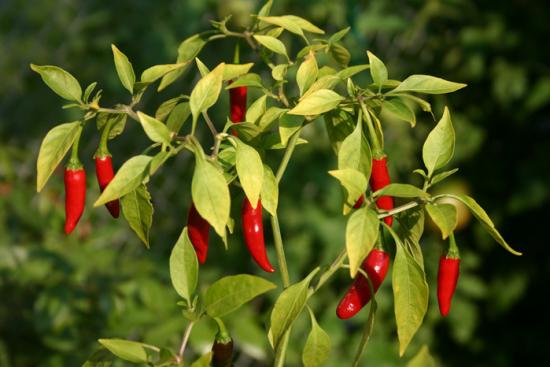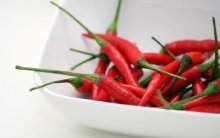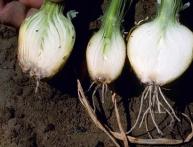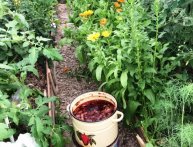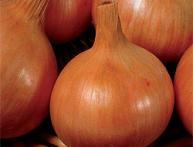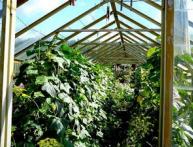Growing chili peppers. What do you need to know?
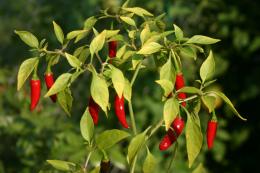
Chili pepper or cayenne pepper is one of the very ancient plants. It is believed that the first harvests of the plant were collected already in the 6-7 millennium BC. The homeland of pepper is Bolivia. As soon as chili became popular throughout Europe, it began to be used as an aromatic spice. Only some time later information was received about its exceptional properties. Thus, it contains large quantities of vitamin A and C. In folk medicine, it is revered for its ability to relieve headaches, cure arthritis, platelets, and also for the prevention of colds and poisoning. Since then, breeders have developed a lot of other varieties of pepper - hot, sweet, hot and many others. It’s surprising that everyone knows about the greenhouse and garden method of growing plants, but not everyone knows that pepper grows well both on the balcony and on the windowsill in the apartment.
Content:
- Preparing pepper seedlings: rules and recommendations
- Planting chili peppers in a permanent place
- Growing chili peppers at home
Preparing pepper seedlings: rules and recommendations
In many ways, chili peppers are no different from any other type of pepper. Its seeds also need to be germinated. To do this, they should be placed between moistened napkins and left there for several days (4-5). This procedure will significantly speed up germination and retain heat. Just a couple of days and the swollen seeds will hatch. After this, they can already be sown.A shallow box is suitable as a vessel. What happens if you ignore manipulations with seed germination and immediately sow them in the ground? Everything is very simple. The seeds will take much longer to hatch. Moreover, each individual type of pepper differs in its germination period. Sometimes it can last up to a month. Important guidelines for planting cayenne pepper seeds:
- The distance between the seeds must be at least 5 cm, otherwise the plant will suffer from a lack of light and, accordingly, will not stretch well.
- The soil must be fertile and supplemented with vermiculite.
- The depth of seed immersion in the soil should be approximately 0.5 cm.
- It is advisable to complete the planting process by irrigating the soil.
In addition to the above rules, you should ensure that humidity is maintained and access to heat is maintained. Each species needs its own temperature regime, but on average the indicators are around 22-25 degrees. Moreover, this temperature is needed constantly. How quickly the seeds germinate depends not only on the conditions created, but also, again, on pepper varieties. As soon as green tongues appear from the soil, you need to change the care of the seedlings. So, you will need more light. Its lack will have a bad effect on the length of the vegetable and its color. The best way to illuminate young plants is artificial light. Moreover, the following points should be taken into account:
- the distance from the lamp to the top of the seedlings should be 25-30 cm;
- 18 hours - this is how long the daylight hours last for peppers;
- It is advisable to install a timer on the lamp, which will ensure accurate compliance with the lighting time.
You can start replanting as soon as the seedlings are decorated with two pairs of leaves.A vessel with a diameter of 8 to 10 cm is suitable for this. Make sure that it is not deep, otherwise the root system will be more developed than the fruiting top.
Planting chili peppers in a permanent place
When the length of young peppers is 10-15 cm, they can be transplanted into a large pot or greenhouse. In this case, wait until the temperature at night reaches 10-12 degrees.
Planting cayenne pepper seedlings in open soil
Experts say that pepper develops much better in greenhouse conditions rather than in open ground. This is explained by controlled temperature conditions and constant humidity levels. Thus, in a greenhouse, chili peppers can grow up to 1 meter in length and bear a huge amount of massive fruits.
If good conditions are created for cayenne pepper, then after some time you will be able to admire a strong, lush bush. If you prefer large fruits compared to their quantity, then simply remove some of the flowers on the plant itself.
As for feeding, the same approval as for tomatoes is suitable for this. Peppers in open greenhouse soil should be watered with plenty of water and regularly. This makes the roots stronger. A plant grown in a pot also needs frequent watering, and on hot days - twice a day.
Growing chili peppers at home
Growing cayenne pepper very similar to caring for tomatoes. Not surprising, because these are two related plants. Pepper requires heat, light, moist, loose soil with good permeability and air. At the same time, the plant cannot tolerate high heat, stagnant water and low temperatures.To grow cayenne pepper at home, you first need to decide on the type of plant. The following types of peppers are best suited for growing in a pot on a windowsill:
- treasure Island;
- martin;
- sweeties;
- Winnie the Pooh;
- Mysterious Island;
- firstborn of Siberia.

